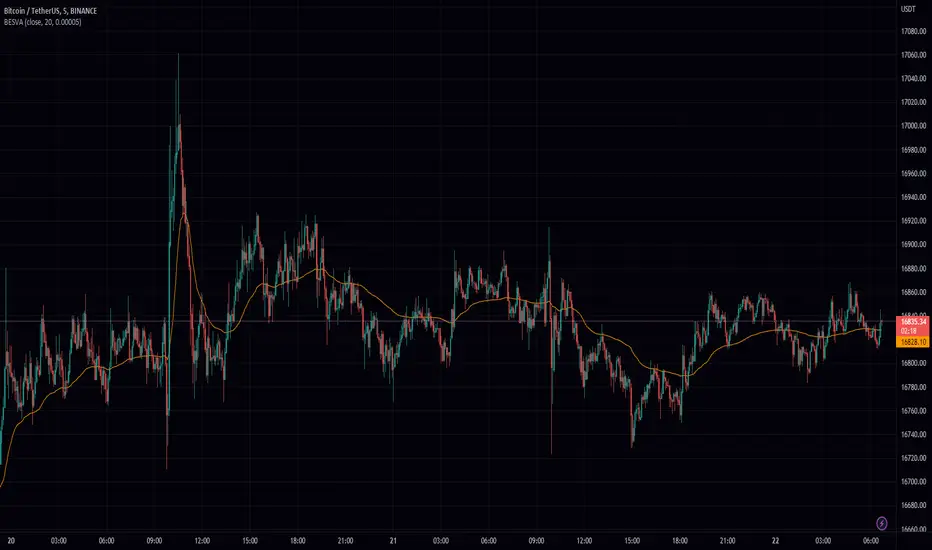OPEN-SOURCE SCRIPT
已更新 Brown's Exponential Smoothing Volatility Adjusted (BESVA)

Introduction:
This script is a technical indicator for financial markets, designed to provide traders with a smoothed version of an asset's price using Brown's exponential smoothing method. The indicator adjusts the smoothing parameter based on the volatility of the asset, resulting in a smoother plot with less volatility and a quicker response to price changes with higher volatility.
Methodology:
The indicator begins by defining a length parameter, which determines the number of bars used in a volatility calculation. The user can input a value for this parameter, with a default of 20 bars.
Next, the script calculates the standard deviation of the asset's close price over the defined length, which serves as a measure of volatility. The standard deviation is then normalized by dividing it by the maximum standard deviation and adding a minimum value (set to 0.00005 by default). This normalization technique ensures that the indicator is comparable across different asset classes and time frames.
The normalized volatility measure is then used to adjust the smoothing parameter for the exponential moving average. Specifically, the smoothing parameter is set to the normalized volatility measure, with the minimum value used when the volatility is at its minimum. As the volatility increases, the smoothing parameter decreases, resulting in a quicker response to price changes.
The resulting smoothed price plot is then plotted on the chart.
Conclusion:
This script provides a useful tool for traders looking to analyze the trends in an asset's price while taking into account its volatility. The adjustable smoothing parameter ensures that the indicator responds appropriately to changes in volatility, making it a valuable addition to a trader's toolkit.
This script is a technical indicator for financial markets, designed to provide traders with a smoothed version of an asset's price using Brown's exponential smoothing method. The indicator adjusts the smoothing parameter based on the volatility of the asset, resulting in a smoother plot with less volatility and a quicker response to price changes with higher volatility.
Methodology:
The indicator begins by defining a length parameter, which determines the number of bars used in a volatility calculation. The user can input a value for this parameter, with a default of 20 bars.
Next, the script calculates the standard deviation of the asset's close price over the defined length, which serves as a measure of volatility. The standard deviation is then normalized by dividing it by the maximum standard deviation and adding a minimum value (set to 0.00005 by default). This normalization technique ensures that the indicator is comparable across different asset classes and time frames.
The normalized volatility measure is then used to adjust the smoothing parameter for the exponential moving average. Specifically, the smoothing parameter is set to the normalized volatility measure, with the minimum value used when the volatility is at its minimum. As the volatility increases, the smoothing parameter decreases, resulting in a quicker response to price changes.
The resulting smoothed price plot is then plotted on the chart.
Conclusion:
This script provides a useful tool for traders looking to analyze the trends in an asset's price while taking into account its volatility. The adjustable smoothing parameter ensures that the indicator responds appropriately to changes in volatility, making it a valuable addition to a trader's toolkit.
發行說明
added double smoothing option開源腳本
秉持TradingView一貫精神,這個腳本的創作者將其設為開源,以便交易者檢視並驗證其功能。向作者致敬!您可以免費使用此腳本,但請注意,重新發佈代碼需遵守我們的社群規範。
免責聲明
這些資訊和出版物並非旨在提供,也不構成TradingView提供或認可的任何形式的財務、投資、交易或其他類型的建議或推薦。請閱讀使用條款以了解更多資訊。
開源腳本
秉持TradingView一貫精神,這個腳本的創作者將其設為開源,以便交易者檢視並驗證其功能。向作者致敬!您可以免費使用此腳本,但請注意,重新發佈代碼需遵守我們的社群規範。
免責聲明
這些資訊和出版物並非旨在提供,也不構成TradingView提供或認可的任何形式的財務、投資、交易或其他類型的建議或推薦。請閱讀使用條款以了解更多資訊。